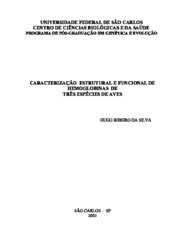| dc.contributor.author | Silva, Hugo Ribeiro da | |
| dc.date.accessioned | 2016-06-02T20:21:34Z | |
| dc.date.available | 2004-06-15 | |
| dc.date.available | 2016-06-02T20:21:34Z | |
| dc.date.issued | 2003-02-25 | |
| dc.identifier.citation | SILVA, Hugo Ribeiro da. Caracterização estrutural e funcional de hemoglobinas de três espécies de aves.. 2003. 109 f. Dissertação (Mestrado em Ciências Biológicas) - Universidade Federal de São Carlos, São Carlos, 2003. | por |
| dc.identifier.uri | https://repositorio.ufscar.br/handle/ufscar/5536 | |
| dc.description.abstract | Hemoglobin electrophoretic patterns, oxygen equilibrium experiments using unfractionated blood, stripped hemoglobin at 4oC, 21oC, 40oC, as well as the effect of inositol hexaphosphate (IHP) and 2,3-biphosphoglycerate (BPG), and the qualitative and quantitative determination of intraerythrocytic organic phosphate were done, in three species of Aves: Athene cunicularia – owl (Order Strigiformes, Family Strigidae), Coragyps atratus - vulture (Order Ciconiformes, Family Cathartidae) and Mimus saturninus - mocking bird (Order Passariformes Family Mimidae). On starch gel electrophoresis, pH 8.6, A. cunicularia and C. atratus showed one slow anodic major component and one fast minor components, a typical bird hemoglobin pattern. On the same electrophoretic conditions, M. saturninus showed two anodic major components, instead one major and one minor. Stripped hemoglobins at the three temperatures, in the presence of IHP, BPG, and blood showed normal Bohr effect and n values (Hill plots) were close to one, indicating very low or no cooperativity. Oxygen affinities were temperature-dependent (as lower the temperature higher is the affinity), BPG modulation was low, IHP was very effective as negative modulator. Vulture hemoglobin showed the highest P50 value, while the owl and the mocking bird presented lower and similar oxygen affinity to each other. No AMP, GTP and BPG were found, only ADP, ATP and inositols were detected in the erythrocytes of the three species. Inositol pentaphosphate (IP5) was the most abundant intraerythrocytic organic phosphate in the 3 species. A. cunicularia showed also inositol tetraphosphate and C. atratus and M. saturninus showed IHP, besides IP5. Although the three species belong to different Orders, have different habit; the functional properties of their hemoglobins are very similar. One hypothesis to explain such similarity is that the avian system to deliver and discharge oxygen to the tissues are so efficient, that works properly in a wide range of situations | eng |
| dc.format | application/pdf | por |
| dc.language | por | por |
| dc.publisher | Universidade Federal de São Carlos | por |
| dc.rights | Acesso Aberto | por |
| dc.subject | Aves | por |
| dc.subject | Hemoglobina | por |
| dc.subject | Efeito Bohr | por |
| dc.subject | Eletroforese | por |
| dc.subject | Inositol pentafosfato | por |
| dc.subject | Equilíbrio de oxigenação | por |
| dc.title | Caracterização estrutural e funcional de hemoglobinas de três espécies de aves. | por |
| dc.type | Dissertação | por |
| dc.contributor.advisor1 | Schwantes, Arno Rudi | |
| dc.contributor.advisor1Lattes | http://genos.cnpq.br:12010/dwlattes/owa/prc_imp_cv_int?f_cod=K4783111U2 | por |
| dc.description.resumo | Foram analisados, o padrão eletroforético, a finidade das hemoglobinas (Hbs) em experimentos de equilíbrio de oxigenação em sangue, hemoglobinas stripped à 4oC, 21oC e 40oC, o efeito de fosfatos orgânicos inositol hexafosfato (IHP) e 2,3 - bifosfoglicerato (BPG), bem como a determinação qualitativa e quantitativa de fosfatos orgânicos em três espécies de Aves: Athene cunicularia – coruja-buraqueira (Ordem Strigiformes, Família Strigidae), Coragyps atratus - urubu (Ordem Ciconiformes, Família Cathartidae) e Mimus saturninus - sabiá-do-campo (Ordem Passariformes Família Mimidae). O padrão eletroforético em gel de amido (pH 8,6), para A. cunicularia e C. atratus, mostra a presença de um componente maior lento, e outro menor rápido, padrão típico de hemoglobinas de aves. Para M. saturninus o padrão eletroforético mostra dois componentes maiores, um rápido e outro lento. As hemoglobinas stripped, nas três temperaturas, na presença de IHP, 2,3 - BPG e em sangue mostraram efeito Bohr normal e valores de n (Hill) próximos de um, indicando cooperatividade muito baixa ou ausente. A afinidade das Hbs ao oxigênio mostrou - se maior a medida que se diminuiu a temperatura. O 2,3 - BPG praticamente não modulou as Hbs, já o IHP atuou como modulador negativo efetivo das Hbs. Não foi detectado concentrações de AMP, GDP, GTP e 2,3 - BPG. Foram detectados somente ADP, ATP e inositóis nos eritrócitos das três espécies. O inositol pentafosfato (IP5) foi o fosfato intraeritrocitário mais abundante nas três espécies. A. cunicularia mostrou também inositól tetrafosfato (IP4) e C. atratus e M. saturninus, mostraram IHP. Apesar das três espécies estudadas pertencerem a ordens diferentes, com tipos de vôo e hábitos distintos, as propriedades funcionais de suas hemoglobinas são muito semelhantes. Já que as três espécies estudadas, com hábitos tão diferentes, apresentam características funcionais tão semelhantes, é possível que esses sistemas sejam tão eficientes que não necessitem modificações significativas para cumprir seu papel de fornecer oxigênio aos tecidos, numa gama grande de situações ecológicas | por |
| dc.publisher.country | BR | por |
| dc.publisher.initials | UFSCar | por |
| dc.publisher.program | Programa de Pós-Graduação em Genética Evolutiva e Biologia Molecular - PPGGEv | por |
| dc.subject.cnpq | CIENCIAS BIOLOGICAS::GENETICA | por |
